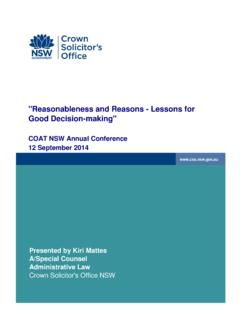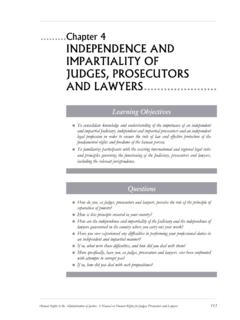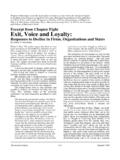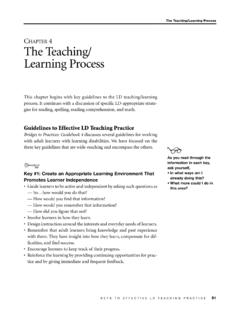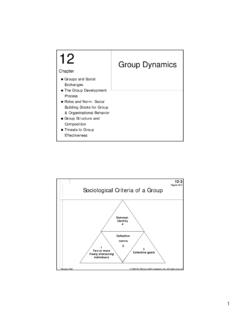Transcription of corrected proofs pam 28 Nov - COAT
1 Associate Professor Pamela O ConnorMonash UniversityTRIBUNAL INDEPENDENCETRIBUNAL INDEPENDENCEA ssociate Professor Pamela O ConnorMonash UniversityiiOrders for this publication should be sent to:The SecretariatThe Australasian Institute of Judicial Administration IncorporatedGround floor, 555 Lonsdale StreetMelbourne Victoria 3000 AustraliaTelephone:(61 3) 9600 1311 Facsimile:(61 3) 9606 0366 Australasian Institute of Judicial Administration Incorporated ( AIJA ) is anincorporated association affiliated with Monash University. Its main functions arethe conduct of professional skills courses and seminars for judicial officers andothers involved in the administration of the justice system, research into variousaspects of judicial administration and the collection and dissemination ofinformation on judicial administration.
2 Its members include judges, magistrates,legal practitioners, court administrators, academic lawyers and other individuals andorganisations interested in improving the operation of the justice AIJA Secretariat, which has been in operation since February 1987, is fundedsubstantially on a composite government funding basis through the StandingCouncil on Law and Justice (SCLJ) formerly known as Standing Committee 2013 The Australasian Institute of Judicial Administration IncorporatedISBN: 978-0-9590029-3-5iiiTable of ContentsForeword .. viiPreface .. ixChapter 1 Introduction and Conceptual 1 Tribunals in the system of .. 1 Reconceptualising the place of tribunals in the system of government .. 4 Judicial independence and tribunal 4 independence from whom?
3 5 independence and .. 6 The conceptual basis for tribunal independence .. 6 Adjudication and impartiality .. 9 Aspects of independence .. 15 Administrative independence .. 17 Institutional independence .. 17 Adjudicative .. 18 Integration of elements in a conceptual model .. 18 Chapter 2: Measuring . 21 Measuring de facto and de jure independence .. 22 Does de jure independence determine de facto independence ?.. 22 Analytic and comparative measurement of 26 Assessment of strength of .. 27 independence and diversity .. 29 Chapter 3: Administrative 33 Embedded tribunals .. 33 Reform through restructuring .. 34 Areas of administrative .. 35 Funding, premises and resources .. 36 Staff .. 38 Chapter 4: Institutional independence : 41 Appointments and tribunal 41 Political appointments.
4 41 Who should have power to recommend appointments? .. 42 Models for appointment processes .. 43A. The nomination model .. 44B. The assessment panel model .. 46C. The Independent Commission model (UK) .. 53 Reflections and conclusions .. 57 Chapter 5: Institutional independence : Security of tenure .. 61 Security of .. 61 Terms and tenure .. 62 Reappointment processes .. 66 Removal provisions .. 69 Security of remuneration .. 74ivChapter 6: Adjudicative 77 Overview of the .. 77 Duty of member to protect own impartiality .. 79 Code of .. 79 Duty to act impartially or independently .. 81 Professional development and .. 82 Duty to maintain confidentiality of information .. 82 Managing conflicts .. 82 Immunity .. 84 Power or Efficacy.
5 85 Scope of tribunal s power to review policy .. 85 Executive .. 89 Chapter 7: .. 91 What is required for independence ?.. 92 Aspects of independence .. 93 Key findings in relation to each .. 95 Administrative independence .. 95 Institutional independence .. 96 Adjudicative .. 99 Concluding .. 101 Appendix A: Heads and Former Heads Interviewed for this Study .. 101 Appendix B: The Eight Areas for Tribunal Excellence .. 102 Appendix C: Comparative Tables of Provisions by Area .. 105 Table C1: Administrative independence .. 105 Table C2: Institutional .. 106 Table C3: Adjudicative independence .. 110vFOREWORDT ribunals are an important part of the justice system. They provide a quick, cheapand relatively informal means of dispute resolution.
6 Like other justice institutions,tribunals rely ultimately on public confidence and the consent of the governed. Theextent to which a tribunal is independent of the Executive influences publicperception about the tribunal s impartiality. Impartiality is essential for thedetermination of just, predictable decisions and the acceptance of those decisions bythe community. It is for this reason that tribunal independence research paper examines the institutional provisions and arrangements thatenable tribunals to perform their functions impartially and independently. On behalfof the Council of Australasian Tribunals (COAT) I welcome the publication of thispaper and congratulate Associate Professor O Connor on this important andsubstantial contribution to the debate about the contextual factors which safeguardimpartial adjudication by Iain Ross AOChairCouncil of Australasian TribunalsviviiACKNOWLEDGMENTThe AIJA is pleased to have been associated with the important researchundertaken by Associate Professor Pamela O Connor on Tribunal AIJA has had a long association with tribunals having, on its own account,for a number of years, and more recently with the Council of Australasian Tribunals(COAT)
7 Conducted the Annual Tribunals is the second occasion on which the AIJA has been associated with andfinancially supported research by COAT, having been involved in the developmentof the Tribunals Bench are due to Associate Professor O Connor, to Justice Iain Ross AO whohas chaired the Steering Committee for the research, Judge Kevin O Connor AM,President of the Administrative Decisions Tribunal of New South Wales and GregReinhardt, Executive Director of the AIJA, who formed the Steering Committee forthe Project. I also acknowledge assistance from the Heads of Tribunals, theExecutive of COAT and those interviewed by Associate Professor O commend the research to Michelle MayPresident, AIJA2013viiiixPREFACEThis is a study of institutional provisions and arrangements that enable tribunalsto perform their functions impartially and independently.
8 The primary function ofAustralian and New Zealand tribunals is the resolution of disputes, and the principalmethod is adjudication. There is a growing international interest in identifying,enhancing and measuring the institutional arrangements that safeguard impartialadjudication by tribunals. They include legislative provisions, common law rules ofjudicial review, government policies, procedures and guidelines, fundingarrangements, service agreements, administrative practices and conventions, culturaland societal norms, values and attitudes. They are found in variable combinationsand interact in complex study was undertaken by Associate Professor Pamela O Connor of MonashUniversity ( the researcher ) under a consultancy agreement with the Council ofAustralasian Tribunals, with a funding contribution from the Australian Institute ofJudicial Administration.
9 The project was carried out in consultation with the fundingbodies, but the views expressed in this report are those of the measurement of independence as an area of tribunal quality raises difficultconceptual questions. We lack a developed theoretical and empirical understandingof the institutional design elements required to secure independence in varioussettings. Since the 1990s, international aid donors have invested in projects to buildjudicial independence in various countries, but no consensus model has of the learning on judicial independence is applicable to tribunals which haveadjudicative functions. There are also factors which are peculiar to the tribunalsector, including the diversity of tribunals, their membership, their place in thesystem of government, and their accountability mechanisms.
10 Tribunal independenceoverlaps judicial independence , but raises distinctive study is premised on the idea that independence is at least partly a function ofinstitutional design for impartial adjudication. It examines the various types oflegislative provisions and other administrative arrangements currently in use, toassess their value in protecting tribunal independence . The success of tribunalsultimately depends upon public trust in the quality and impartiality of theiradjudication, but institutional safeguards for independence help to reinforce publictrust. They are also the factors which are readily observable and liable to changethrough direct policy research for the study comprised three stages: a literature review, alegislation review, and a series of interviews with tribunal heads.
